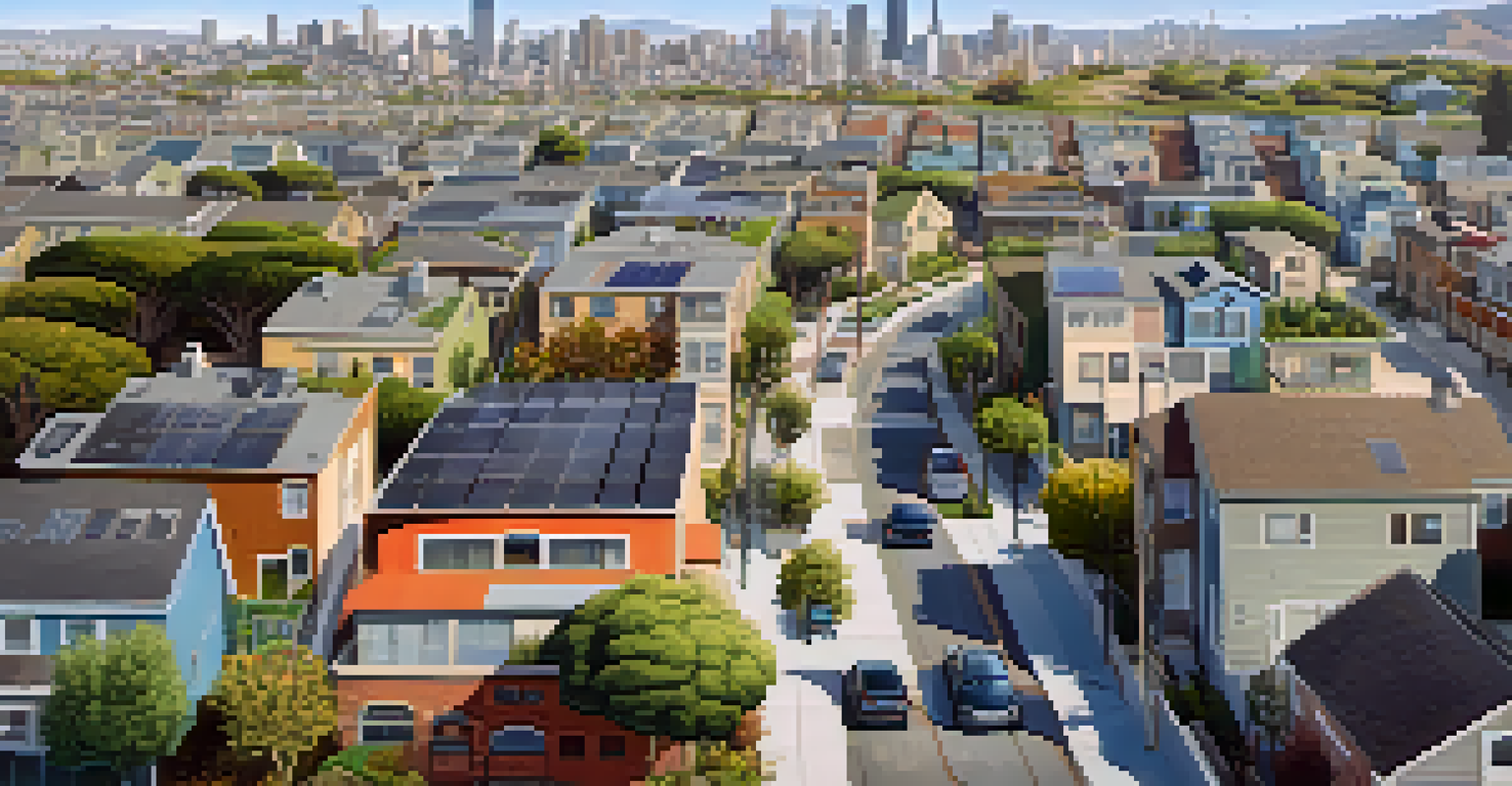The Effect of Climate Change on San Francisco Real Estate

Understanding Climate Change and Its Local Impacts
Climate change refers to long-term shifts in temperatures and weather patterns, primarily driven by human activities. For cities like San Francisco, this means rising sea levels, increased temperatures, and more frequent extreme weather events. Understanding these changes is crucial for homeowners and investors looking to navigate the real estate market.
Climate change is not just a future problem; it is happening now and affecting our homes and communities.
In San Francisco, the effects of climate change are already evident, with rising sea levels threatening the waterfront areas. This can lead to flooding and erosion, which not only impacts property values but also influences insurance rates and housing demand. The local government is taking steps to mitigate these risks, but the future remains uncertain.
Moreover, the increasing frequency of wildfires and heat waves in California adds another layer of concern for residents. As climate change continues to evolve, so too do the expectations of buyers and sellers in the San Francisco real estate market.
How Rising Sea Levels Affect Property Values
As sea levels rise, properties near the coast are at greater risk of flooding and damage. This has led to a decline in property values in certain areas, especially those that were once prime real estate locations. Potential buyers are becoming more cautious, leading to shifts in demand that can drastically alter the market landscape.

For example, neighborhoods like Mission Bay and Embarcadero, once considered desirable, are now scrutinized for their vulnerability to future sea level rise. Homebuyers are increasingly seeking properties in higher elevations, which affects pricing and availability in those areas. This shift illustrates how climate change is directly influencing buyer behavior.
Climate Change Impacts Real Estate
Rising sea levels and extreme weather are reshaping property values and buyer behavior in San Francisco.
Investors are also reconsidering their portfolios, leading to a potential slowdown in new developments along the waterfront. The long-term implications for real estate investment in San Francisco could be significant, as properties in at-risk areas may struggle to maintain their value.
The Role of Climate Resilience in Urban Planning
Urban planning in San Francisco is increasingly focused on climate resilience, which refers to the ability of a city to adapt to the impacts of climate change. This involves designing infrastructure and housing that can withstand rising sea levels and extreme weather. As a result, real estate developers are now prioritizing sustainable practices in their projects.
The best time to plant a tree was 20 years ago. The second best time is now.
For instance, the city has implemented new building codes that require elevated structures in flood-prone areas. This not only protects the properties but also reassures potential buyers about the longevity of their investments. By emphasizing climate resilience, San Francisco aims to maintain its appeal in the face of environmental challenges.
Additionally, green spaces and urban parks are being integrated into city planning, providing both environmental benefits and enhancing property values. This proactive approach reflects a growing understanding that addressing climate change can also lead to more vibrant, livable urban environments.
Impact of Extreme Weather on Housing Demand
Extreme weather events such as heatwaves, heavy rainfall, and wildfires are becoming more common in California. These occurrences can disrupt daily life and influence housing demand significantly. For example, during heatwaves, many residents seek homes with air conditioning and access to cooling centers, which can shift demand toward specific neighborhoods.
Wildfires, particularly, have led to increased caution among homebuyers. Many are now considering the risk of wildfires when looking for properties, which may drive them away from areas that are historically prone to such disasters. As a result, regions that were once highly sought after may see a decrease in interest.
Insurance Costs Rise for Homeowners
Increasing risks from climate change are leading to higher insurance premiums and stricter coverage for coastal and wildfire-prone properties.
Moreover, insurance rates are rising due to the increased risk associated with extreme weather. This financial burden can deter potential buyers and lead to a reevaluation of home investments in affected areas. The interplay between extreme weather and housing demand is reshaping the real estate landscape in San Francisco.
Insurance Challenges in a Changing Climate
As climate change intensifies, insurance companies are adjusting their policies and premiums to reflect the increased risks. In San Francisco, homeowners are experiencing rising costs and stricter coverage conditions, particularly for properties near the coast or in wildfire-prone areas. This shift can make home ownership less accessible for some buyers.
For instance, properties located in high-risk zones might face challenges in securing affordable insurance, leading to decreased demand. Homebuyers are now more informed about these risks, often considering insurance implications when making purchasing decisions.
Additionally, some insurers are pulling out of high-risk markets altogether, leaving homeowners with fewer options. This creates a ripple effect in the real estate market, as potential buyers may shy away from properties that could become financially burdensome due to insurance costs.
The Shift Toward Sustainable Real Estate Development
Sustainability is becoming a key focus in real estate development, especially as climate change continues to pose challenges. Developers in San Francisco are incorporating eco-friendly materials and energy-efficient designs to appeal to environmentally conscious buyers. This trend is not just a response to climate change; it’s also a selling point in a competitive market.
For example, buildings that use renewable energy sources, like solar panels, are gaining popularity. Buyers are increasingly attracted to homes that lower their carbon footprint and offer long-term savings on energy costs. As this trend grows, it’s likely to reshape the types of properties being developed and marketed in the city.
Sustainability Drives Development Trends
Developers are focusing on eco-friendly materials and energy-efficient designs to attract environmentally conscious buyers in a competitive market.
Moreover, by prioritizing sustainability, developers can also navigate regulatory requirements more effectively. The city encourages green building practices, which can lead to faster approvals and potential financial incentives. This aligns with the broader goal of creating a resilient urban environment while meeting the demands of the modern buyer.
Community Responses to Climate Change in Real Estate
Communities in San Francisco are increasingly banding together to address climate change and its effects on real estate. Neighborhood associations and local organizations are advocating for policies aimed at increasing climate resilience and sustainable development. These grassroots efforts are becoming critical in shaping the future of local real estate markets.
For instance, community-led initiatives often push for improved infrastructure, such as better drainage systems and flood barriers. By engaging residents in these discussions, cities can prioritize projects that reflect the community's needs and concerns, ultimately leading to more sustainable outcomes.

Additionally, these community responses can influence property values, as areas that actively address climate risks tend to attract more buyers. A community's commitment to sustainability and resilience can enhance its appeal, creating a positive feedback loop that benefits both residents and real estate investors.